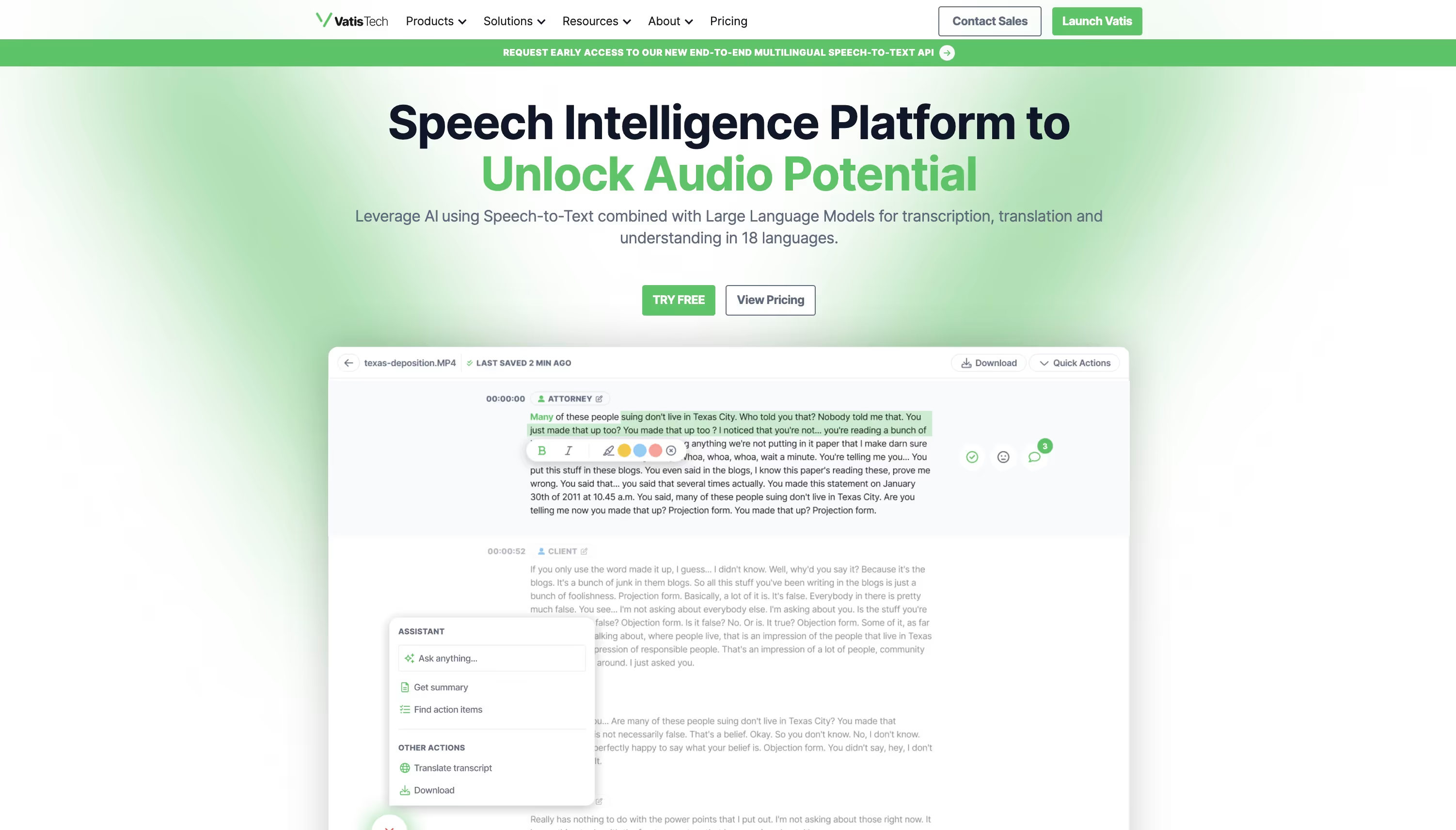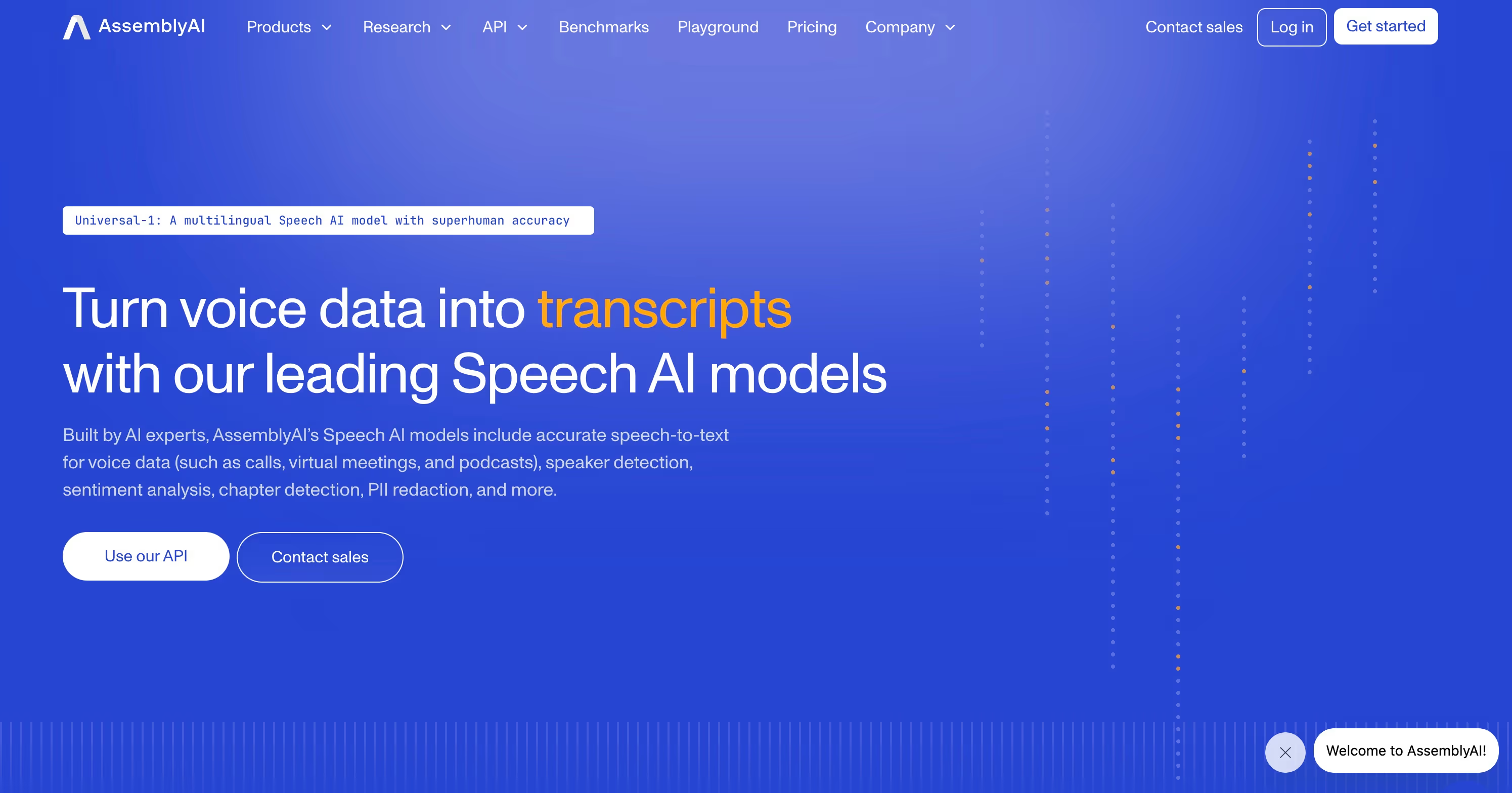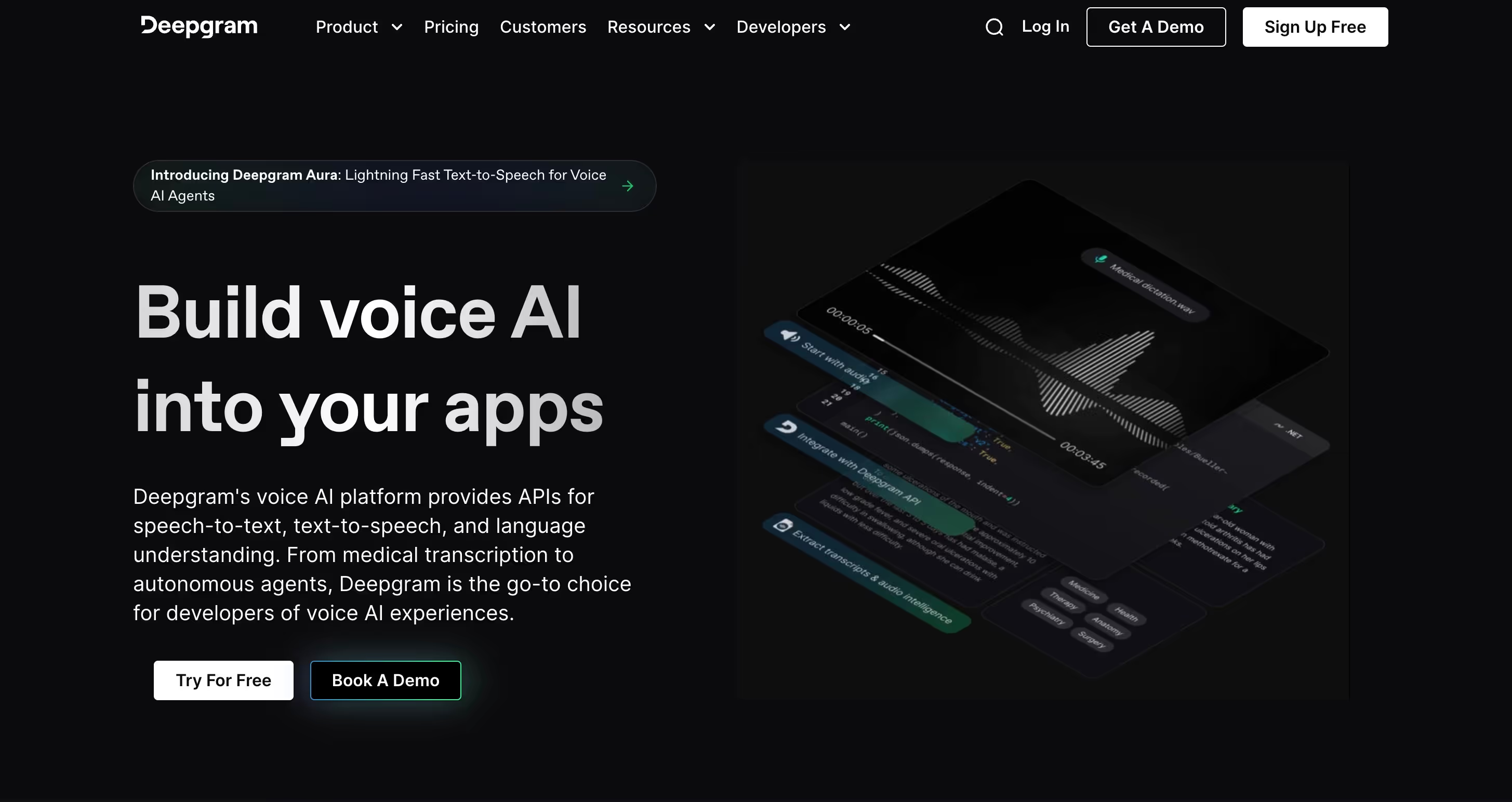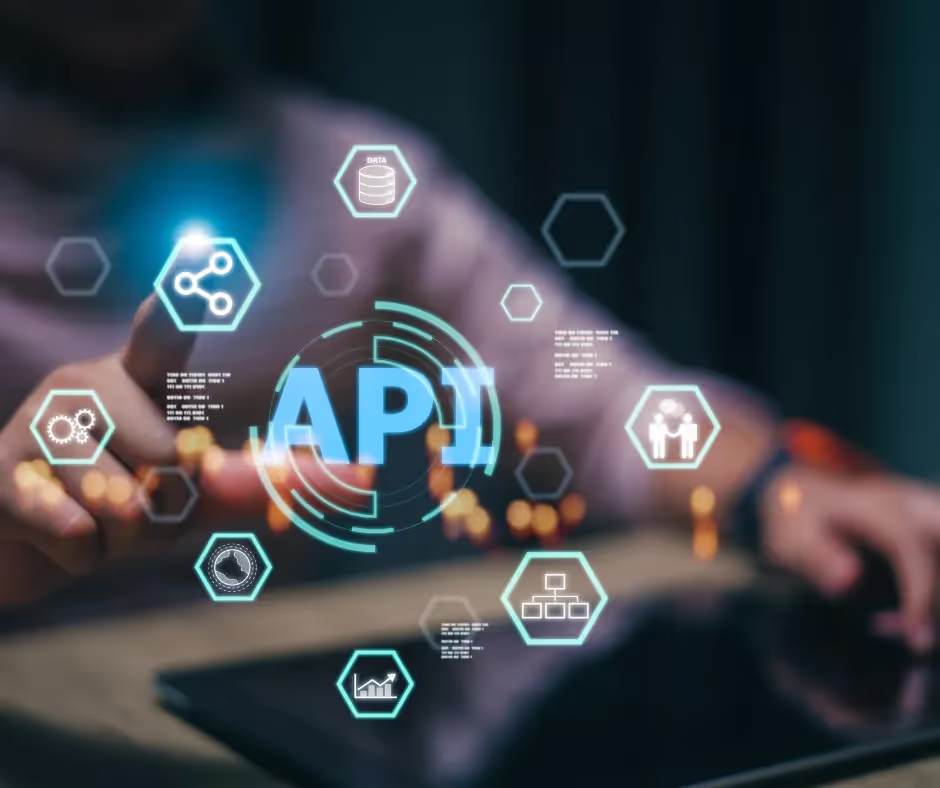TABLE OF CONTENTS
Experience the Future of Speech Recognition Today
Try Vatis now, no credit card required.
In today's digital landscape, the ability to seamlessly convert spoken words into written text is more crucial than ever. Whether you're looking for medical transcription, need to integrate voice commands, or desire free transcription services, the right automatic speech recognition (ASR) technology can be a game-changer.
In this guide, we'll explore some of the top contenders and emerging players offering free tiers or completely open-source speech-to-text solutions in 2025. We'll dive into the pros, cons, and key features of each option to help you find the best fit for your needs.
Cloud-Based Speech-to-Text APIs
Google Speech-to-Text
Powered by Google's advanced ASR systems and artificial intelligence, the Google Speech-to-Text API enjoys widespread popularity.
Pros:
- Supports multiple languages.
- Exhibits a decent accuracy.
- Transcribes pre-recorded files or real time audio.
- Speaker diarization.
- New users receive up to $300 in free credits to explore ASR technology and other Google Cloud services
Cons:
- The $300 in free credits only applies to transcribing audio files that are stored in a Google Cloud Bucket.
- You need to sign up for a GCP account, and create a project to start using the STT services and managing any of the Google Cloud services.
- Can involve setup and configuration overhead with Google Cloud Platform.
- Lower accuracy than other similarly-priced APIs.
- In case of multiple channel audio, each audio channel is billed separately.
The pricing model is structured based on the amount of audio processed per month and whether data logging is enabled.
Amazon Transcribe
Amazon Transcribe, an AWS service, uses ASR models for converting speech to text via API, supporting multiple languages, real-time transcription, and custom vocabularies.
Pros:
- Free Tier: Get started without immediate costs for testing and smaller projects. 60 minutes of transcription per month for the first 12 months.
- Multiple languages transcription, both for batch transcription and streaming.
- Support for Multiple Channels: The pricing includes support for two audio channels at no additional cost. This means if an audio file has two separate channels for different speakers, the user is only charged for the total audio duration, not per channel.
- Add-On Services: Amazon Transcribe offers additional services such as automatic content redaction and custom language models, which add value for users needing these specific features.
- Call Analytics: Optional extension for in-depth analysis of call transcripts (note: separate pricing).
Cons
- Pricing Complexity: Tiered pricing and multiple feature add-ons can make cost estimation tricky.
- Transcription Accuracy: While generally average transcription, accuracy may vary depending on audio quality and specialized vocabulary.
- Additional Costs for Add-Ons: While useful, services like custom language models and automatic content redaction are billed additionally, which could significantly increase the overall cost for users who require these features frequently.
- Only 14 languages supported for real-time transcription
- Usage is billed in one-second increments, with a minimum per request charge of 15 seconds.
Pricing Model: Pay-as-you-go: No upfront commitments, cost scales with your usage. Tiered pricing: Discounts for higher volume use.
Microsoft Azure
Microsoft Azure's ASR systems provide speech-to-text, text-to-speech, and translation on one platform.
Pros:
- Unified Services: Offers speech-to-text, text-to-speech, and speech translation in one platform.
- Customizable transcription models: Offers flexible customization for speech-to-text models to meet specific business requirements, with additional costs for tailored features.
- Free Tier Available: 5 audio hours per month for experimentation.
- Multilingual Support: Capable of handling various languages
- Batch Transcription and Real Time transcription with a slightly smaller subset of languages compared to Batch.
- Language Identification and Diarization Included in the Batch transcription.
- Flexible Pricing: Offers both pay-as-you-go and commitment-based pricing, accommodating different budget and usage patterns.
- Azure Integration: Works with other Azure services, making it a good fit for solutions within the Azure ecosystem.
Cons:
- Pricing Complexity: The various pricing options, tiers, and feature add-ons can make it difficult to accurately estimate costs.
- Technical Expertise: Setting up and optimizing the services, especially for advanced features or customization, may require a certain level of technical knowledge.
- The accuracy level is generally good, typically achieving rates just below 90%.
- Free audio hours is shared between Standard and Customised, Batch is not supported.
- Additional cost for: Real Time Language identification, diarization, pronunciation Assessment, and multi channel audio transcription.
Pay-as-you-go: billed per second of audio and Commitment Tiers: discounted rates if you commit to a monthly usage volume. Factors Affecting Price: Standard vs. Custom Models - Custom models cost slightly more. Add-on Features: Diarization and language identification incur additional charges.
Specialized Speech-to-Text Providers
Vatis Tech
Vatis Tech is gaining recognition for its advanced ASR technology and transcription models.

Pros:
- Impressively state-of-the-art AI models for exceptional accuracy: 90%+
- Easy to use end-to-end multilingual speech-to-text API: transcription, translation and audio intelligence.
- Identification of speakers through voiceprint technology
- Silence detection with audio silence not billed, ensuring fair pricing
- Transcribe any file,regardless of format, size or duration
- Support for unlimited transcription concurrency
- Fine-tuning options to tailor models to specific domains (like medical or technical).
- Offers a 2-month Free Trial upon request for early access.
Cons:
- Can be less established than older providers.
Pricing: Primarily subscription-based, but a free trial is available for experimentation.
AssemblyAI
AssemblyAI is a trusted choice in the ASR technology space, excelling in accuracy for domain-specific applications.

Pros:
- Excels in accuracy, particularly for domain-specific use cases.
- 20 Supported languages for Best model
- Offers features like sentiment analysis and content moderation.
- Free tier provides up to 100 hours of audio.
Cons:
- Need to employ a combination of API features to access diverse functionalities.
- Automatic language detection is supported only for 5 languages.
- Streaming Speech-to-Text is only available for English, and only 2 formats supported.
- Can be more expensive than some alternatives for high-volume usage.
- Speaker Identification available only for 10 languages
- The possibility to detect important phrases and words available only in English.
- Sentiment Analysis available for 4 languages
- Overall the audio intelligence features are available for a limited selection of languages.
Pricing: Freemium model with tiered pricing based on usage. You can choose from different pricing tiers to access the models and capabilities that best suit your needs.
Deepgram
Deepgram, a popular choice for accurate ASR systems, balances essential speech-to-text features with advanced audio intelligence.

Pros:
- Accuracy: Deepgram is known for its competitive accuracy
- Feature Range: Provides a good balance of essential speech-to-text capabilities and text to speech, alongside with more advanced audio intelligence features.
- Straightforward Pricing: Transparent pricing tiers with clear explanations.
- Free Tier: Offers a generous $200 credit to try out the platform.
- Nova-2, their best performing speech to text model is available for 34 languages both for Pre-recorded and Streaming
- Supports tailor-made models.
Cons:
- The Nova-2 speech-to-text business models, designed for specific industries like meetings, medical, phone calls, finance, and automotive, are currently available exclusively in English.
- The Audio Intelligence features, including Sentiment Analysis, Intent Recognition, Topic Detection, Summarization, and Entity Detection, are currently only available in English and for pre-recorded files. These features are not available for real-time transcription.
Pricing: three primary pricing tiers, Pay-as-You-Go, Growth, Enterprise. Speech-to-Text Model Choice: Base, Enhanced, Nova1, Nova 2, or Whisper models come at different price points. Text-to-Speech: Billed per character generated. Audio Intelligence: Features have individual pricing.
Open-Source Speech Recognition Models
Whisper (Open AI)
Whisper is a powerful open-source ASR model that provides high accuracy and resilience to background noise.
Pros:
- Whisper is open source and freely available for modification and use.
- It supports batch transcription in multiple languages.
- Robust to background noise and varying audio quality.
- Pre-trained models available: there are 5 model sizes, 4 with English-only versions, offering speed and accuracy tradeoffs.
- The .en models for English-only applications tend to perform better, especially for the tiny.en and base.en models.
- Supports translation between several languages and language identification.
Cons:
- Requires significant computational power for optimal performance.
- May not perform well on very specialized domains or niche audio types.
- The accuracy typically ranges from 85% to 87%, and generally does not surpass 90%.
- Does not support real time transcription.
- Being pre-trained, it offers limited customization compared to commercial speech-to-text APIs that allow model training on specific data.
Pricing: Completely free and open-source. However, costs can arise from the computational resources needed to run the model, especially when using cloud services.
Wav2Vec (Facebook AI, currently Meta Platform)
This open-source transcription model from Meta uses self-supervised learning to minimize labeled data needs, making it a top choice for customized ASR systems.
Pros:
- Open-source and customizable for specific domains.
- Self-supervised learning approach requires less labeled data for training.
- High-Quality Performance on English language benchmarks.
Cons:
- Complex Implementation: can be more challenging to implement compared to simpler models.
- Often requires additional fine-tuning on specific datasets to achieve optimal performance, which can be resource-intensive.
Pricing : Free to use through libraries like Hugging Face Transformers.
NeMo (NVIDIA)
NVIDIA’s NeMo framework is designed for large-scale speech applications, optimized for GPU usage and offering a variety of ASR models.
Pros:
- Designed for large-scale, production-grade speech recognition applications.
- Optimized for GPU acceleration, leading to fast inference times.
- Supports a variety of model architectures and training methods.
- Includes pre-trained models for various languages and tasks.
Cons:
- Requires expertise in deep learning and GPU programming.
- Higher infrastructure requirements for running and training models.
Pricing: The Nemo framework itself is open-source and free to use. However, the cost of GPU resources for training and running the models is dependent on your provider and usage.
Choosing the Right Speech-to-Text Solution
Finding the best ASR systems for your needs requires careful consideration of several key factors:
- Accuracy and Specialization: How critical is pinpoint accuracy? Some solutions excel in specific domains like medical or legal transcription.
- Language Support: Need to transcribe multiple languages? Evaluate the breadth of language support offered by each provider.
- Ease of Integration: Seamless integration with your existing workflows is crucial. Look for APIs with clear documentation and easy-to-use SDKs.
- Cost and Scalability: Balance upfront costs with long-term scalability. Consider tiered pricing models that adapt to your growing needs. Some APIs may have premium pricing for advanced features or higher accuracy levels.
- Customization: Need to fine-tune the model for your specific data or industry jargon? Assess the level of customization offered by each solution.
Types of Speech-to-Text Solutions:
- Big Tech APIs: Giants like Google, Amazon, and Azure offer robust, cloud-based transcription services, often with generous free tiers. They are a good starting point for diverse needs.
- Specialized STT APIs: Companies like Vatis Tech, AssemblyAI, and Deepgram focus on specific domains and use cases, providing tailored solutions with advanced features like speaker diarization and sentiment analysis.
- Open-Source Solutions: Whisper, Wav2Vec, and NeMo empower technically proficient teams to build custom solutions with greater control. However, they require more technical setup and maintenance.
To help you make an informed decision, we have prepared a comparative table across all these players.
The Right API for Long-Term Growth
A powerful speech-to-text API can be a catalyst for long-term growth. By enhancing your products and services with accurate and efficient transcription, you can:
Unlock new revenue streams: Offer transcription as a standalone service or enhance existing offerings.
Improve operational efficiency: Automate tasks, reduce manual effort, and streamline workflows.
Enhance customer satisfaction: Provide a better user experience with features like real-time captioning and multilingual support.
Take the time to explore the available options and choose an API that aligns with your business needs and technical capabilities.








.avif)
